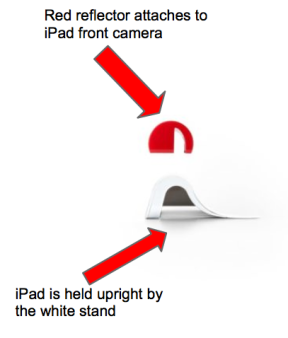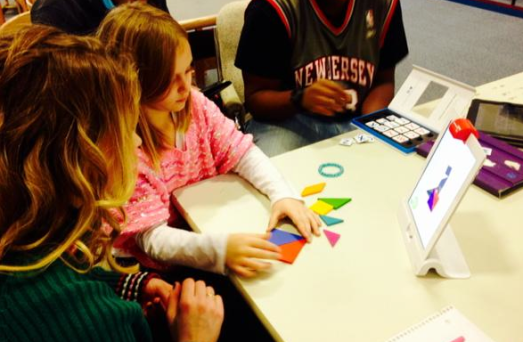This post originally appeared on TJ Horgan’s help desk blog
 Osmo, a unique gaming accessory for the iPad, was created by Tangible Play, Inc. in 2014, and that is exactly what Osmo is. Osmo uses groundbreaking reflective artificial intelligence technology and is the epitome of tangible play, as it introduces kinesthetic learning opportunities for developing minds and closes the gap between the digital and physical worlds. A kinetic learner myself, I was immediately drawn to the presentation of this tool. In essence, the Osmo is a simple reflector that is placed on the iPad’s front camera, which projects the surface directly in front of the iPad to the camera. However, the impressive craftsmanship is exemplified by the seamless integration of tangible images projected and displayed to the iPad’s screen. The Osmo started kit comes with a base and reflector, Tangram and Words games pieces and three apps: Tangram, Newton, and Words. To access the the apps, users will launch Safari and navigate to www.playosmo.com/start.
Osmo, a unique gaming accessory for the iPad, was created by Tangible Play, Inc. in 2014, and that is exactly what Osmo is. Osmo uses groundbreaking reflective artificial intelligence technology and is the epitome of tangible play, as it introduces kinesthetic learning opportunities for developing minds and closes the gap between the digital and physical worlds. A kinetic learner myself, I was immediately drawn to the presentation of this tool. In essence, the Osmo is a simple reflector that is placed on the iPad’s front camera, which projects the surface directly in front of the iPad to the camera. However, the impressive craftsmanship is exemplified by the seamless integration of tangible images projected and displayed to the iPad’s screen. The Osmo started kit comes with a base and reflector, Tangram and Words games pieces and three apps: Tangram, Newton, and Words. To access the the apps, users will launch Safari and navigate to www.playosmo.com/start.
WORDS
The first app, Words, engages learners by asking them to guess an on-screen hidden word by lining up the letter game pieces. Students can play alone, or teachers can encourage healthy competition by allowing students to race against their classmates to practice word recognition and spelling. Teachers can elect to use the existing library of images, or create their own image libraries. Words is an example of how well Osmo recognizes minuscule differences in paper so quickly. Osmo can recognize a letter as soon as it is placed within about 8 inches of the iPad. Though my experimenting with incorrect placements came at the frustration of my second grade Osmo partner, Mrs. Scheffer’s eight-year-old daughter, I soon became impressed with how advanced, but, at the same time, simple, the letter recognition is. Osmo can distinguish the specific letter and color of the mini-card instantaneously, and, not only is it impressive, but it is useful, for developmental spelling and word association skills.
TANGRAM

Tangram, appropriate for ages 4+, is the most tangible of Osmo’s three creations, as the user is tasked with matching plastic puzzle pieces to a design displayed on the iPad’s screen. There are three levels of the game; easy, medium, and hard which allow teachers to customize the level of play for his or her students. Mrs. Scheffer’s daughter became bored with Tangram relatively quickly, as she soared through each level with no problems. Ideally, students over the age of seven would not be using this app too heavily.
NEWTON
Newton is the most challenging tool that is packaged with Osmo, as it incorporates advanced spatial relation skills into an ultimate, clear-cut, goal and achievement. Virtual pellets are dropped from the top of the screen, and the user’s mission is to draw a series of obstacles that reroute these pellets to a series of targets. The obstacles, however, are drawn with an actual pen on actual paper. Osmo registers the lines drawn on your blank canvas and adds them to the on-screen course. With added targets and added pellets, the challenges get more difficult, but are definitely attainable. This is the one tool on Osmo that I saw Mrs. Scheffer’s daughter’s interest genuinely pique.
Overall, Osmo is a well-developed tool that can improve the spatial relations, spelling, and problem-solving skills and abilities of elementary school-aged students. Osmo could fairly easily fit into a math or English curriculum. The Osmo kit retails for $79.99, which is an affordable price for a school district if they are looking to continue to innovate in the classroom with technologically engaging devices. Gathering from my conversation with Mrs. Scheffer, she believes that the Osmo would be a beneficial addition to a “center” in an elementary classroom, giving students an opportunity to rotate through an individualized or collaborative learning station.




No comments:
Post a Comment